July 10, 2020
Air Date: July 10, 2020
FULL SHOW
SEGMENTS
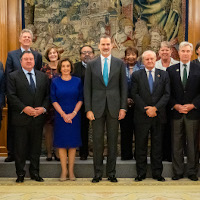
Democratic Climate Action Plan
View the page for this story
After more than a year of consideration, the members of the House Select Committee on the Climate Crisis have released a massive climate action plan that aims to end carbon pollution and build new clean energy and transportation systems, while also helping communities adapt to climate disruption. Select Committee on the Climate Crisis Chair Kathy Castor (D-FL) joins Host Steve Curwood to discuss what the plan means for environmental policy and environmental justice communities moving forward. (14:13)
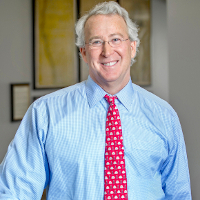
Beyond the Headlines
/ Peter DykstraView the page for this story
This week Peter Dykstra, Weekend Environmental Health News Editor and Host Steve Curwood cover the fall of a major fracking company, the end of the road for the Atlantic Coast Pipeline, and the shutdown of the contentious Dakota Access Pipeline pending more environmental review. They discuss President Trump’s downplaying the lethality of COVID-19, which has hit close to home. And they take a trip back to the 1995 Midwest heat wave that previewed the growing health risks of climate disruption. (04:15)

Guinea Fowl and Tick Control
/ Jenni DoeringView the page for this story
Deer ticks can carry Lyme disease, a debilitating disease if left untreated, and one that’s becoming more common thanks to the warming climate. Now some homeowners in the thick of tick country are turning to guinea fowl to control ticks. Living on Earth’s Jenni Doering reports from Exeter, New Hampshire about one family’s experience with these tick-eating machines. (07:39)
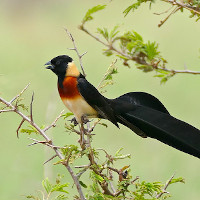
BirdNote®: The Paradise-Whydah
/ Mary McCannView the page for this story
BIRDNOTE®: THE PARADISE-WHYDAH: Imagine if you had to grow your own evening gown just to attend a party. That's essentially what males of the East-African songbird species the Paradise-Whydah do every breeding season. These little finches sprout incredible tail feathers, many times the length of their bodies, all so the females of the species get to pick who wore it best. BirdNote®’s Mary McCann has the scoop. (02:14)
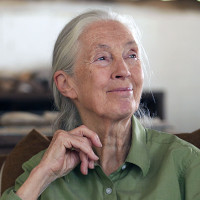
Jane Goodall On 60+ Years of Conservation And Research
View the page for this story
The iconic Jane Goodall has spent her life advocating for the conservation of the natural world. Sixty years ago on July 14th, 1960, Jane arrived in what is now Gombe National Park, Tanzania, to begin her groundbreaking research on chimpanzees. Jane Goodall joins Host Steve Curwood to discuss her career studying chimps, the work her organization is doing now, and what we can learn about our relationship with the natural world from the current pandemic. (19:24)
Show Credits and Funders
Show Transcript
HOST: Steve Curwood
GUESTS: Kathy Castor, Jane Goodall
REPORTERS: Jenni Doering, Peter Dykstra, Mary McCann
[THEME]
CURWOOD: From PRX – this is Living On Earth.
[THEME]
CURWOOD: I’m Steve Curwood.
House Democrats unveil a sweeping plan to help "solve the climate crisis" by investing in a green economy.
CASTOR: We have 40 million Americans who are out of work now. And we think that there is an exciting pathway for folks to go to work building the macrogrid, the supergrid, that we'll need to connect renewable power sources -- solar, and wind -- to the population centers across the country.
CURWOOD: Also, 60 years ago Jane Goodall followed her dream when she first went into the forest with chimpanzees.
GOODALL: I sat there looking out over the lake and these trees and a troop of baboons came by and I heard a bushbuck barking and it was like this is my dream come true. I’m in Paradise.
CURWOOD: That and more this week on Living on Earth – Stick Around!
[NEWSBREAK MUSIC: Boards Of Canada “Zoetrope” from “In A Beautiful Place Out In The Country” (Warp Records 2000)]
[THEME]
Democratic Climate Action Plan
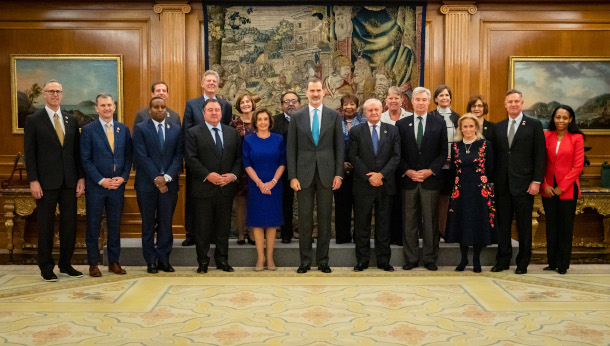
After more than a year of consideration, the House Select Committee on the Climate Crisis have introduced a massive climate action plan. Here, members of the Committee are pictured, alongside Speaker Nancy Pelosi at the 2019 United Nations Climate Change Conference (Photo: John Brighenti, Flickr, CC BY 2.0)
CURWOOD: From PRX and the Jennifer and Ted Stanley Studios at the University of Massachusetts Boston, this is Living on Earth. I’m Steve Curwood.
After more than a year of consideration, the Democratic majority members of the House Select Committee on the Climate Crisis have come up with a massive, 538-page plan for climate action. Their report pinpoints hundreds of measures to end carbon pollution and protect public health with climate-friendly economic, transportation and energy systems, and an end to subsidies for fossil fuels. With a focus on environmental justice, their plans call for conserving public lands, farmland and forests to lock up carbon, and also helping communities adapt to climate disruption. The chair of the Climate Crisis Committee, Kathy Castor of Florida joins us now from the Capitol. Welcome back to Living on Earth!
CASTOR: Thank you so much, Steve.
CURWOOD: So first, how does it feel to finally be able to release this report to the Congress?
CASTOR: Well, I'm especially excited to be with you because I spoke with you at the outset, over a year ago, when Speaker Pelosi and the Democrats in Congress directed the establishment of a new Select Committee on the Climate Crisis and tasked us with talking to stakeholders all across the country, every political persuasion, folks really at the grassroots and develop solutions for the Congress. They directed us to be ambitious, and we've delivered an ambitious report.
CURWOOD: Well, talk to me about some priorities. It's, it's kind of like you have 10 hungry children, you love them all. But you have limited resources. How do you set priorities? What's your top priority here?
CASTOR: The top priority is the clean energy economy. The plan says we have to decarbonize American society by the year 2050, but in the various sectors of the economy, we propose, we've got to act a lot faster. And the one that is the top priority really will be establishing a clean energy standard to clean up our grid no later than 2040. So that means we've got to get to work right away to do that. The other top priority is the transportation sector because now there are more emissions coming out of the transportation sector than even the power sector. So we propose clean electric vehicles and set a goal of all new cars to be clean electric vehicles no later than 2035.
CURWOOD: How is this plan going to advance environmental justice and systemic racism?
CASTOR: As you know, there are many communities across America that have carried the burden for entirely too long. They're the communities where the industrial plants are sited in their neighborhoods, time after time. You know, we consulted all across the country and I remember a trip to Detroit, Michigan where I talked to environmental justice leaders. And even before the murder of George Floyd, we were focused on building our climate action plan upon a foundation of environmental justice and fair labor standards for workers. So environmental justice recommendations are embedded throughout our report. For example, the Environmental Protection Agency, when they make permitting decisions or they are trying to determine where to deploy community clean energy resources, community solar, we say that our environmental justice communities must come first.
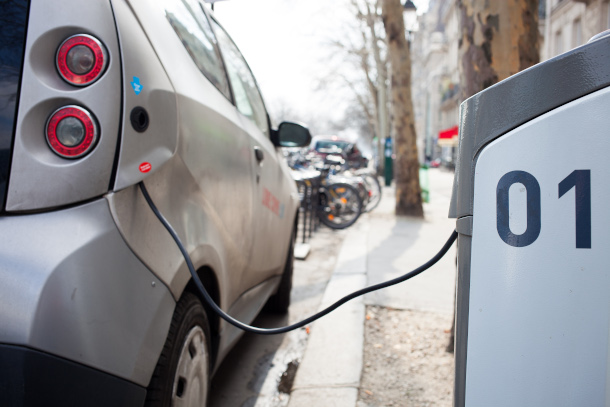
Electric vehicles are central to the House Select Committee on the Climate Crisis’ plan, which aims for all new cars to be electric by 2035. (Photo: Håkan Dahlström, Flickr, CC BY 2.0)
CURWOOD: Congresswoman, the climatologists are talking about this being possibly the warmest year on record. With searing heat waves this summer, there will be air conditioning bills that some won't be able to afford. How does, how does this moment relate to the need to address the climate and equity?
CASTOR: It's interesting that you mention that because my hometown of Tampa, Florida just last week set an all time high temperature record, they broke through to 99 degrees. And in Miami, they haven't really been able to cool off at night. So this is real to people. And you're right, the electric bills are going to be astronomical. So this is part of the, the cost. And I think, in the past, the opponents of climate action have often argued, "it's too expensive for us to act on climate, it's too expensive to make these changes." People don't believe that anymore because they know, they are paying those higher air conditioning bills or property insurance or flood insurance bills or for your stormwater fees. So this is a plan that will benefit all of us, by reducing greenhouse gases and moving to the clean energy economy, that will benefit all of us. Rebuilding better, rebuilding in a more resilient way, giving our local communities the tools they need to prevent flooding, to be sure they're ready for the more intense hurricanes, to be able to handle the wildfires. There are extensive recommendations on how the federal government can be a better partner to communities all across the country.
CURWOOD: Of course, with the COVID recession, there have been and there are going to be more stimulus bills, Congress is going to put forth money to help rebuild the economy. What does your report tell us how we should rebuild the economy in the wake of this COVID recession?
CASTOR: This is a, an enormous opportunity for America to rebuild better. We had an independent think tank look at our plan and model it out. And not only do we get about 90% of the way towards reducing emissions by 2050, they say that we'll create over 500,000 jobs as we transition to the clean energy economy. We will save 62,000 lives annually if we move to the clean energy economy. But it's the jobs focus that is particularly important at this moment in time because we have 40 million Americans who are out of work now. And we think that there is an exciting pathway for folks to go to work, building the macro grid, the super grid that we'll need to connect renewable power sources, solar and wind. These are the jobs in making our communities more resilient. We propose reinvigorating the Civilian Conservation Corps, which was a President FDR idea back in the Great Depression. We propose a new Climate Resiliency Corps to help communities, especially environmental justice communities, do things to make, handle extreme heat, like planting trees in, in formerly redlined neighborhoods or helping with natural solutions -- reinvigorating, you know, turning our public lands into places that aren't exploited for mining and, and fossil fuel development, but are places we can capture carbon. You know, a lot of places all across the globe are already planning these kind of recovery plans. And we see an exciting opportunity for America to do so as well.
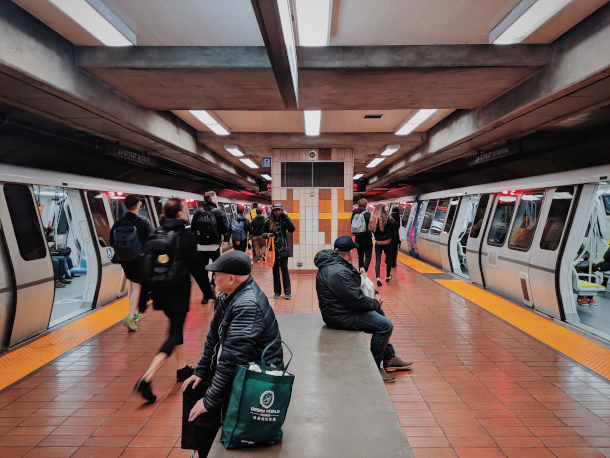
The House Select Committee on the Climate Crisis’ plan would divert funding to more efficient public transportation. (Photo: Vinicius Depizzol, Flickr, CC BY 2.0)
CURWOOD: Now, you mention that the plan calls for a national supergrid using high voltage direct current transmission as opposed to the three big grids we have right now in America, right? We have an East, and we have a West, and we have Texas. And if you did that, right, it would make it possible for us to be 80% renewable with, with the balance of the baseload being handled by existing nuclear. Okay, great idea. But how heavy a lift is this going to be, do you think, to implement a nationwide high voltage DC grid? There's money questions; there's rights of way questions.
CASTOR: You bet. But this is a top priority. Because most, most folks aren't aware that most renewable resources -- this, big solar arrays and wind power -- most of those resources exist between the Rocky Mountains and the Mississippi River. So that has to be our goal, to connect those less expensive renewable resources to population centers across the country. We recommend investing in research and development into storage of these resources. We recommend significant investment in energy efficiency, which pays dividends; if you can help businesses and consumers save on their electric bills, that's a plus. We have to do all of these things and you know, our task is urgent. So here's some good news. Just this week, the House Democrats passed a major transportation and infrastructure bill, the Moving Forward Act, HR 2. And a lot of the Select committee's Solving the Climate Crisis recommendations are contained in that transportation and infrastructure bill. So we, we're already getting started on the infrastructure planning for the transmission supergrid, or macro grid.
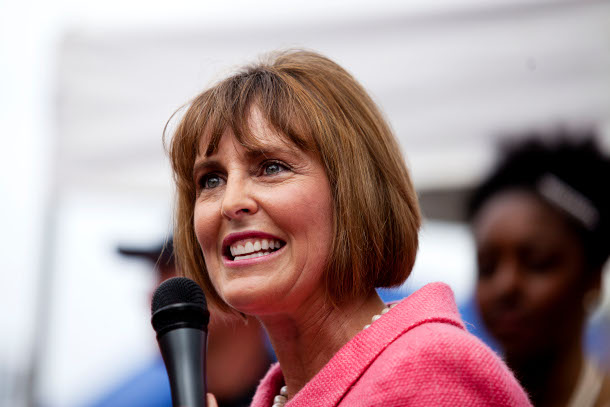
Florida Congressional Representative Kathy Castor, chair of the Climate Crisis Committee, speaks at a Planned Parenthood Rally on August 29, 2012. (Photo: PBS NewsHour Follow, Flickr, CC BY 2.0)
CURWOOD: By the way, the plan talks about a lot of resources getting promised to the fossil fuel industry for carbon capture and storage. But look, 25 years after that technology was first proposed and some pilot efforts mounted it has yet to become cost effective. Why should taxpayers keep spending money on this?
CASTOR: No, taxpayers should not keep spending money on that. We recommend that any of the tax incentives and appropriations that go to fossil fuel, that they are ended over time and shifted to clean energy resources. And in fact, the Moving Forward Act that passed the House of Representatives this week, extends a lot of our clean energy tax credits. Our report says for carbon capture and storage, if an industry proposes to use it, and they're going to increase their carbon footprint, that won't be allowed. We, we recommend that there have to be some climate guardrails. We also believe that there are some industries out there, where there are no solutions right now in how to capture their carbon, meaning, steel, the way we make cement, and other industrial processes. And we think that that type of carbon capture and storage could be an important solution. But we have to, we have to develop the technology that doesn't exist right now.
CURWOOD: And oh, by the way, the report calls for protecting at least 30% of all US lands and ocean areas by 2030. Kind of sounds to me a bit like what Tom Udall over on the Senate side has been saying for a while. Where are we now on meeting that goal and how do we get to 30% by 2030? And why is this so important for the climate?
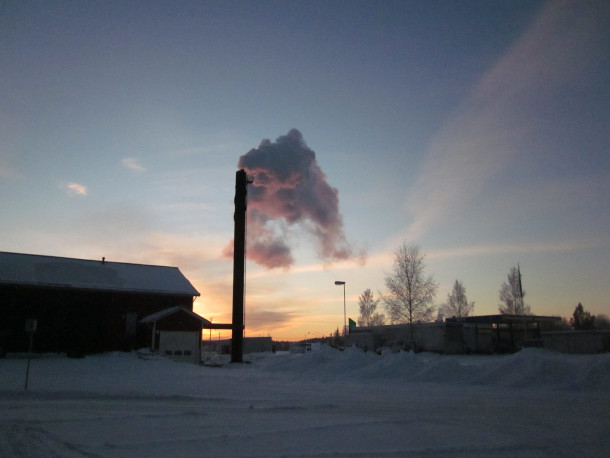
The House Select Committee on the Climate Crisis’ plan focuses on curbing U.S. carbon emissions by 2050. (Photo: Bubblejewel96, Flickr, CC BY 2.0)
CASTOR: Vitally important to the climate that we do not continue to exploit our public lands and offshore waters. In fact, they can really be drivers of carbon solutions, whether that's sequestering carbon or preventing the overdevelopment of our farmlands and protected spaces. People love our national park systems, they love the natural wilderness areas. But we need to understand that they are vital to carbon sequestration and climate action. There's a lot of extraction allowed on our public lands right now; we think over time, that needs to come to an end, and we need to make a broad based commitment to protecting those public spaces.
CURWOOD: That's right, there's almost 500 gigatons of carbon just in America's public lands. How did your committee's on-site field visits help inform this report? You talked about environmental justice in one case, but which other ones specifically were most informative and enlightening?
CASTOR: Yeah, I traveled to the Hampton Roads area with Congresswoman Elaine Luria, we visited a military installation in Norfolk that is dealing with the cost of rising sea levels. We also went with her and Congressman Don McEachin out to an area that floods repeatedly and they're having to relocate some neighborhoods there; that was impactful. And then just up the road, Congressman Bobby Scott took me to a neighborhood that also repeatedly floods. It's a lower income neighborhood. And the folks there told me they don't want to leave when it floods, that's their home. All of that helped influence our recommendations on flood mapping and how we make flood insurance more affordable to people, how we empower communities to understand what the climate risks are going to be in the future so they can make determinations where they're going to buy a home, where they're going to live, and empower the local communities to develop some resiliency plans, some adaptation plans over time. Traveling to Motor City in Detroit and meeting with Ford and GM and then with a lot of the auto workers was inspiring because they're already on track to transition over to the clean electric vehicles. They see it as a significant competitiveness issue with China and the European Union. And that inspired us to push hard when it comes to electric vehicles. We think we can be the world leader when it comes to manufacturing the clean cars and trucks. We went to California, Southern California where they're building the clean electric buses. We envision a future that's not too far off where every child in America who has to ride a bus to school, it's going to be a clean electric bus, and that's going to provide tremendous benefits to the air our kids breathe, too. You got me on a roll here [LAUGHS] -- I wish in the COVID days we could travel, but we're not going to be able to do that. We're going to do a lot of this virtually. But I'm excited to amplify the recommendations in our report and keep listening to folks all across this diverse country as we move our recommendations into law.
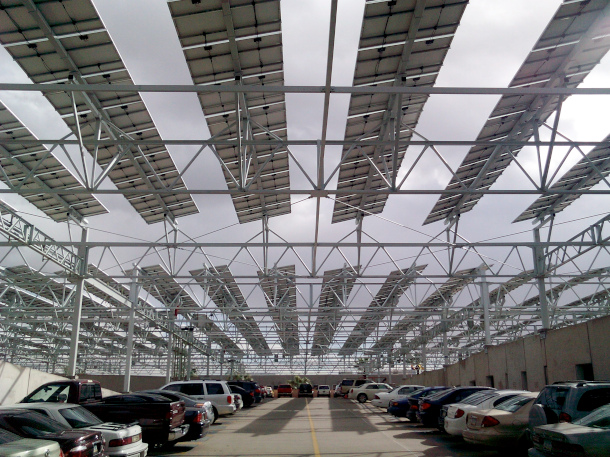
Experts say building new renewable energy infrastructure and transitioning to a clean energy economy under the Climate Crisis Committee’ plan would create more than 500,000 new jobs. (Photo: Kevin Dooley, Flickr, CC BY 2.0)
CURWOOD: Democrat Kathy Castor is the Chair of the House Select Committee on the Climate Crisis and serves Florida's 14th district. Congresswoman, thanks so much for taking the time with us today.
CASTOR: Oh, thank you so much, Steve. And let's have another check-in on our, make sure we're working through this to-do list down the road.
Related links:
- KQED | “Here’s What’s Inside House Democrats’ New Climate Plan”
- Washington Post | “House Democrats unveil ambitious climate package, steering toward a net-zero economy by 2050”
- Grist | “House Democrats finally have a goddamn climate plan”
[MUSIC: Jeremiah McLane, “Genova” on Freetown, by Jeremiah McLane, Epact Records]
CURWOOD: Coming up – They are kinda flat and noisy, and they are a tick’s worst nightmare. Guinea hens are just ahead on Living on Earth.
ANNOUNCER: Support for Living on Earth comes from Sailors for the Sea and Oceana. Helping boaters race clean, sail green and protect the seas they love. More information at sailors for the sea dot org.
[CUTAWAY MUSIC: Jeremiah McLane, “June” on Freetown, by Jeremiah McLane, Epact Records]
Beyond the Headlines
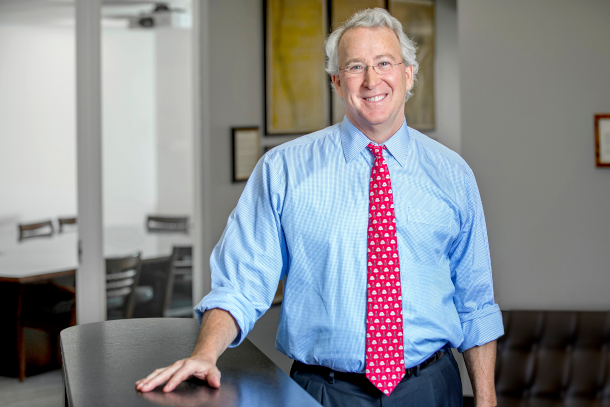
Aubrey McClendon was the co-founder and CEO of Chesapeake Energy until he was indicted on Federal antitrust charges in 2015. (Photo: Oklahoma Riversport Events, Flickr, CC BY 2.0)
CURWOOD: It's living on Earth I'm Steve Curwood and it's time now to take a look Beyond the Headlines with Peter Dykstra. Peter is an editor with Environmental Health News that's EHN.org and DailyClimate.org. And he's on the line now from Atlanta, Georgia. Hey there, Peter, how you doing? What do you got for us today?
DYKSTRA: Hi, Steve. Well, you know, the end of June was a really, really bad time for one of the pioneering biggest, baddest fracking companies in the United States. Chesapeake Energy on June 28 they filed for Chapter 11 bankruptcy after being a Fortune 500 company for the last few years.
CURWOOD: What happened to them?
DYKSTRA: They've kind of fell apart. The prices of oil and gas have fallen way, way down. Concerns about the environmental costs of fracking also began to weigh on the company. And they're also kind of an emblem for what's going on with fracking everywhere.
CURWOOD: Hmm, interesting. Hey, what else do you have from the world of energy? Since the price is down there's gotta be more news.
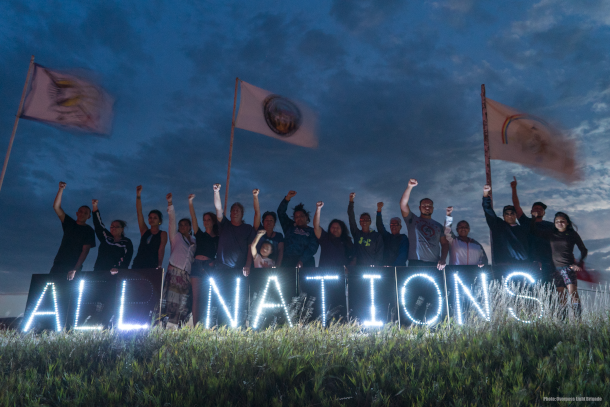
Protesters resisting the Dakota Access Pipeline in North Dakota’s Sacred Stone Camp. (Photo: Joe Brusky, Flickr, CC BY-NC 2.0)
DYKSTRA: Oh, there's plenty more and because the price is down, the pipeline industry is also having a tough time of it. Duke Energy and Dominion Energy decided to quit their 600 mile multi-billion dollar pipeline project, bringing gas through West Virginia, Virginia and the Carolinas. They cited litigation and declining oil prices in killing the Atlantic coast pipeline. Was also the object of protests all along this route, particularly the part where the pipeline ducks under the Appalachian Trail.
CURWOOD: Well, hikers won't have to worry about that one now, apparently.
DYKSTRA: No, they won't. But wait, Steve, there's more.
CURWOOD: Okay.
DYKSTRA: A federal judge shut down an existing pipeline the Dakota Access Pipeline, one of the most contentious objects of litigation and protests by Native Americans, by environmentalists, farmers, ranchers, property rights advocates. The judge said that environmental review conducted by the Army Corps of Engineers was nowhere near adequate, they would have to do that over again before the pipeline would be allowed to reopen.
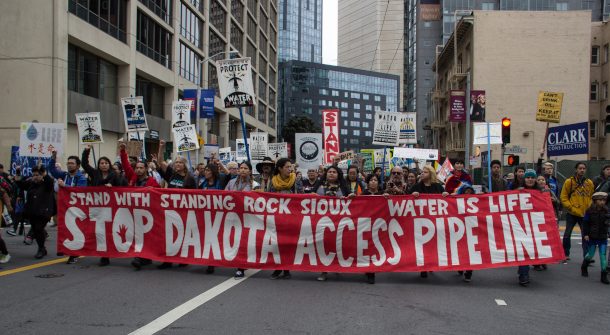
Protesters in San Francisco stand in solidarity with the Standing Rock Sioux tribe against the Dakota Access Pipeline. (Photo: Peg Hunter, Flickr, CC BY-NC 2.0)
CURWOOD: Okay, Peter, what else do you have this week?
DYKSTRA: Well, I was kind of struck by President Trump's saying that 1% of COVID cases were a big deal and the rest were harmless. So I grabbed the old calculator. There are 130,000 US deaths and climbing—that includes my mom last month. There are nearly 3 million diagnosed cases at the time we're recording this, and that's not 1% that's about 4%. And what struck me about it is that Mr. Trump makes a lot of wild claims. They contradict what he said what others have said but rarely are his wild claims so instantaneously, disprovable, 4% are dead and that's a big deal.
CURWOOD: Oh, Peter. I'm so sorry to hear about your mother.
DYKSTRA: Yes, thanks. And Trump, by the way, has made the same kind of wild claims about climate change, and about land use in the Western states. All of that federal land, managed by the Bureau of Land Management, which we will now call the other BLM.
CURWOOD: Yes. Okay, Peter. So it's time now to pull out the history books and tell me which page you've turned to.
DYKSTRA: 25 years ago, page July 13 1995. A heatwave enveloped the Midwest, 739 people died in the city of Chicago alone. That heatwave was a very, very early look at how ugly climate change could be. And also was a look at how climate change can be an environmental justice issue because an overwhelming number of those 739 deaths in Chicago were in African American and Latinx neighborhoods.
CURWOOD: Thank you. Peter Peter Dykstra is an editor with Environmental Health News, that’s EHN.org and DailyClimate.org. And we'll talk to you again real soon.
DYKSTRA: All right Steve, thanks a lot. Talk to you soon.
CURWOOD: And there's more on these stories at the Living on Earth website. That's LOE.org.
Related links:
- Environmental Health News | “A Fracking Giant's Fall”
- Bloomberg | “Fracking from Revolution to Money Pit”
- WFAE 90.7 | “Duke, Dominion Cancel Contested Atlantic Coast Pipeline”
- AP News | “Judge Orders Dakota Access Pipeline Shut Down Pending Review”
- New York Times | “Trump Falsely Claims '99 Percent' of Virus Cases Are ‘Totally Harmless’”
- Chicago Sun Times | “Former County Health Chief: Racism Common Factor in Deaths in ‘95 Chicago Heat Wave, Covid 19”
[MUSIC: Snarky Puppy, “Thing of Gold (groundUp)” December 16, 2011, at Shapeshifter Lab in Brooklyn, New York, for GroundUP Music]
Guinea Fowl and Tick Control
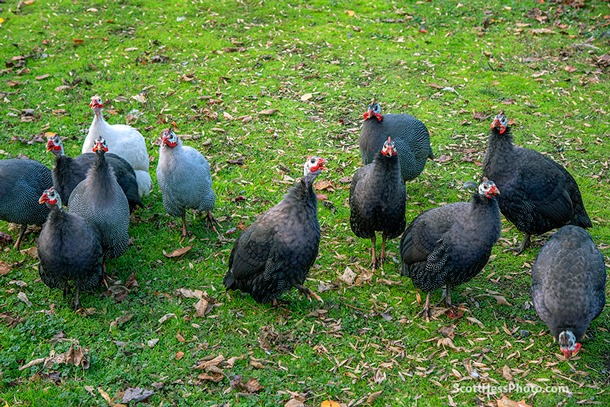
Guinea fowl like to forage for ticks, mosquitoes, fleas, beetles, spiders, and more. (Photo: Scott Hess, Flickr, CC BY-NC 2.0)
CURWOOD: It’s the height of tick season and in the eastern U.S., beware of the blacklegged or deer tick that can carry Lyme disease, which if left untreated, can spread to joints, the heart, and the nervous system. And research shows climate change is making it even more common. One US study found that boosting average temperatures by 2 degrees Celsius could increase Lyme disease cases by 20 percent. Luckily, there are proven ways to reduce your risk. Wear long sleeved clothing, use repellents, and do a thorough tick check after you’ve been walking outside in the woods, or meadows where ticks can hide. And Living on Earth’s Jenni Doering reports from Exeter, New Hampshire about another way to combat ticks in your back yard.
[FOREST SOUNDS]
DOERING: Suzy and Hazel Koff live an enchanted childhood.
On a warm July day, the 6 and 3-year-olds run through the sun-dappled forest in their New Hampshire backyard.
[SOUNDS OF KIDS RUNNING AND PLAYING]
SUZY: Okay, come out!... No, no, no, no, no!
DOERING: Their mother, Sarah, says this is how they spend their summer.
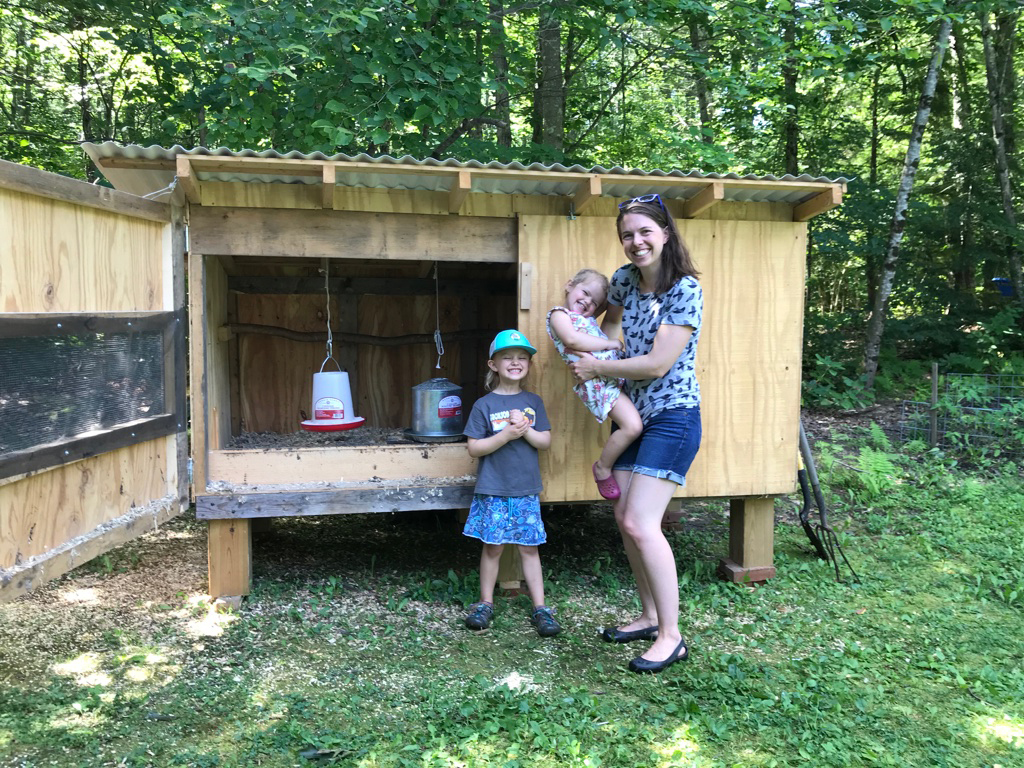
Sarah Koff with daughters Suzy, 6, and Hazel, 3, in front of the guinea fowl coop in their backyard. (Photo: Jenni Doering)
KOFF: We love going outside playing in the woods. We have this great big yard that they play in and we have a sandbox out here and slack line and all sorts of things; we like to make fairy houses, and we like to garden together. So, yeah we’re outside pretty much every day.
DOERING: But in the Northeast, where there are woods, there are ticks. A lot of them.
KOFF: I was so, just, overwhelmed by the ticks in our yard. I’m a big gardener and my daughters – I just feel like it’s really important for them to spend as much of their time outside as possible. And you know, we live in the woods. And so in April and May, they were just coming in with ticks every day on them – and my husband was and I was – and it was just getting too much; I was so overwhelmed and I just, I’m such a big gardener, there’s no way I was willing to spray anything on the lawn or use any sort of chemicals at all, so I thought I would try this biological control…
DOERING: Enter the guinea fowl --
[GUINEA FOWL CALLING]
DOERING: Native to Africa, guineas are rather awkward, football-shaped birds with a tiny head, and a voracious appetite for ticks. And unlike chickens, guinea fowl won’t peck at your garden greens. So Sarah decided to give them a try.
KOFF: Yeah, I just went on Craigslist and I pretty easily found… there were actually a lot of different ads for people selling guineas but we wanted a certain amount and we wanted them to be babies, so it was a perfect guy who had them and raised them and told me a lot about them.
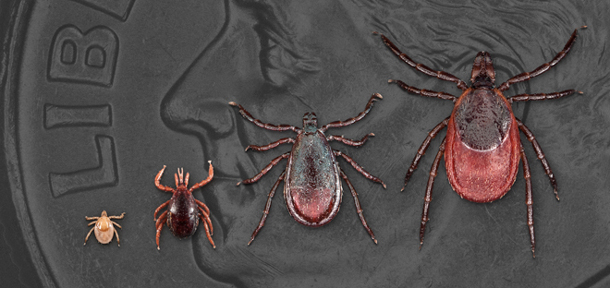
From left, the larvae, nymph, adult male and adult female forms of the blacklegged or deer tick, which can carry Lyme disease. (Photo: CDC)
[GUINEA FOWL CALLING]
DOERING: The Craigslist guineas got right to work.
KOFF: As soon as we started letting them out they were immediately interested in pecking, pecking and pecking. So yeah, they were just sort of tearing up all the bugs! [LAUGHS]
DOERING: Sarah and the kids showed me to a cute little wooden coop with a tin roof, and a single, black and white speckled guinea fowl inside. Sarah unlatched the door and with Hazel’s help, tried to coax the timid bird outside.
[DOOR LATCH SOUND]
KOFF: Hello?
HAZEL: Guinea, you can come out now! What are they doing in there?! [LAUGHS]
DOERING: Is it pretty scared?
KOFF: Well, you know what, they’ve always been scared of us. They’ve always been scared. They’re not, they’re not pets.
HAZEL: Yeah…
KOFF: They’re sort of wild animals that you just have. – There you go.
HAZEL: Ah ha! That’s it.
DOERING: The guinea sprints down the coop’s ramp – and straight into the forest.
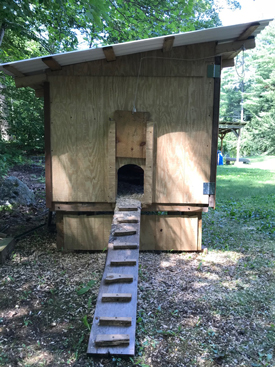
The Koffs’ coop keeps the guinea fowl safe from predators at nighttime, but they’re vulnerable during the daytime when they roam around eating ticks and other bugs. (Photo: Jenni Doering)
KOFF: I don’t think he’ll go very far. He doesn’t usually go very far. Yes, there he is. And we could also give him some scratch. You want to give him some scratch?
[BAG RUSTLING, FEED SPRINKLING ON GROUND]
SUZY: Hey, come on and eat it! You’re not eating it!
DOERING: Why just the one?
KOFF: Well, we used to have eight, but then earlier this week, unfortunately, seven of them disappeared; and we don’t know what happened but we think that they were either killed or ran away; were definitely spooked by some predator, because we did find one dead hen, so.. yeah it’s really sad.
[GUINEA CALLING]
DOERING: Finally we spot the elusive guinea in a neighbor’s yard.
KOFF: Oh. There she is, right there, do you see it?
HAZEL: Where is she?
KOFF: Under the bushes.
DOERING: Before the guinea fowl massacre, Sarah says she noticed a dramatic decline in the number of ticks on her family.
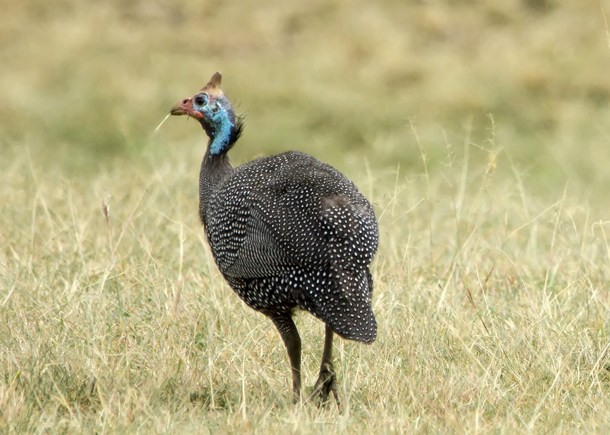
Guinea fowl are native to Africa. Above, a wild guinea fowl in Kenya’s Maasai Mara National Reserve. (Photo: Marc, Flickr, CC BY-NC-ND 2.0)
KOFF: I haven’t seen any ticks on the kids since we’ve let the guineas go roam around. And my husband I think has found one on himself so far.
DOERING: A small 1992 study on Long Island backs up Sarah’s observation.
Researchers placed guinea fowl into tick-infested areas and found that they significantly reduced the adult tick population within the enclosures. But Howard Ginsberg, a research ecologist with the Department of Interior, points out a problem with timing.
GINSBERG: Most people get Lyme disease during June and July when the nymphs are out, and the nymphs are in the woods. The adults, which are the stage that’s targeted by these birds, is out in the fall and spring, out in open areas like people’s lawns; and some people get Lyme disease that way but not most people. So there may be some effect, but in general it’s not going to solve a disease problem.
DOERING: In fact, another study in New York State from 2004 found that where guinea fowl were allowed to range freely, ticks in the nymph stage weren’t reduced, so the Lyme disease risk remained high.
Still, a single female deer tick can lay as many as 2,000 eggs, so removing adult ticks does appear to reduce local Lyme disease risk overall. Fortunately, even if a tick latches on to you, Ginsberg says time is on your side.
GINSBERG: Lyme disease, that bacterium requires something like 24 to 48 hours with tick attachment before it’s transmitted. So if you do a check every day when you get back from the woods and remove ticks, you have eliminated the possibility of Lyme disease fairly substantially.
DOERING: And if you do find a tick embedded in your epidermis…
GINSBERG: The best way to remove a tick is to just take fine tweezers, just grab as close to the skin line as possible, and slowly pull it straight out.
DOERING: Then, take some rubbing alcohol and clean the bite thoroughly.
And get that tick safely out of your life by flushing it down the toilet.
[GUINEA FOWL CALLING]
DOERING: So, does Sarah plan to replenish the flock?
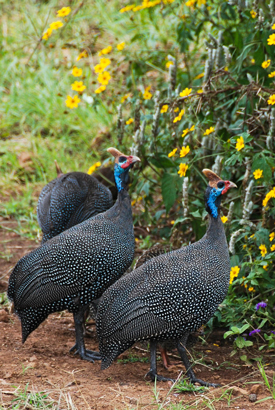
Guinea fowl target adult ticks, not the nymphs, which are more likely to infect a human with Lyme disease. (Photo: Chris.Murphy, Flickr, CC BY-ND 2.0)
KOFF: So we are feeling a little bit unsure of how to proceed with just one right now. They’re very social creatures and they really do need to be with others, and so I’m actually in the middle of deciding whether we bring in some more, maybe some babies, for this one to raise; or do we try to re-home this guinea to a place that has guineas already?
DOERING: No matter what they decide, Sarah says the ticks won’t stop her and the kids from getting outside.
KOFF: Kids need to be just exposed to nature as much as possible and we’re so lucky to be living in a place that – we have the woods right in our backyard; we have a trail that we can connect to from our backyard. There are so many studies that show that it relieves anxiety in kids; it just makes them be more independent, more creative, have a bigger imagination, and just more comfortable in the outdoors, which is -- I mean, it’s therapy. But I also just check them for ticks every day and I try not to be anxious about it, because there’s not too much I can do about it other than check them thoroughly.
DOERING: With a thorough head-to-toe check, even the smallest ticks can be found before they pose a Lyme disease risk. For Living on Earth, I’m Jenni Doering in Exeter, New Hampshire.
[GUINEA FOWL CALLING]
Related links:
- 1992 study about guinea fowl reducing adult deer ticks
- 2004 study that found that guinea fowl do not reduce tick nymphs
- Lyme disease and climate change
- CDC on how to remove a tick
- CDC nformation on tickborne diseases
[BIRDNOTE THEME]
BirdNote®: The Paradise-Whydah
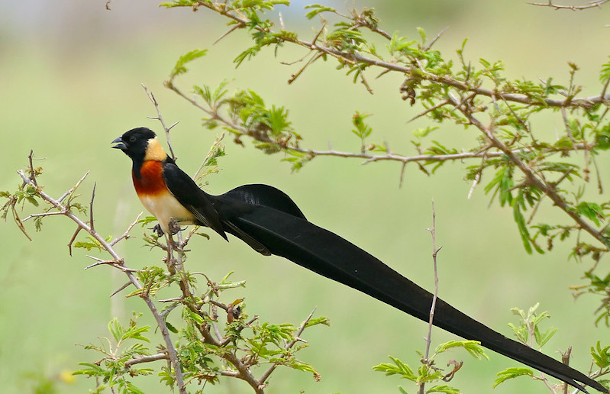
The exact reasons for intricate breeding displays like that of the male Eastern Paradise Whydah are still up for debate within the scientific community. But whatever the reason, this Whydah catches eyes with his long trailing tail feathers. (Photo: Bernard Dupont, CC).
CURWOOD: We stay with African birds with this Birdnote from Mary McCann.
BirdNote®
Paradise-Whydah
[Paradise-Whydah song, https://macaulaylibrary.org/asset/28128281#_ga=2.130237135.1927678623.15..., 0.22-.28] A few times each year, the Eastern Paradise-Whydah puts on its party clothes. This small finch, found in East Africa, is just five inches long, with a black tail, brown back, and patterned face markings. But when it’s time to mate, the male molts into breeding plumage. His head turns glossy black, his neck golden yellow, and breast a vivid orange.
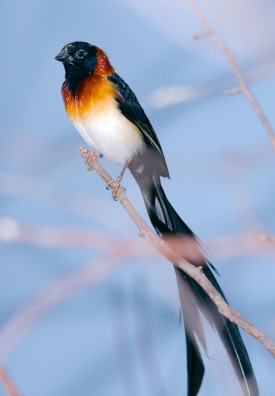
Not every male Paradise-Whydah is “Mr. Right”. (Photo: Josh More, CC)
But the best part? He sprouts extravagant, long, black tail feathers two or three times the length of his body. [Paradise-Whydah song, https://macaulaylibrary.org/asset/28128281#_ga=2.130237135.1927678623.15..., 0.22-.28] The male Paradise-Whydah’s tail feathers are not just super long but also broad, as if they belonged to a much bigger bird. It almost looks like the bird is wearing a long black cape. That’s how it got its nickname, “the widow bird” -- because it looks like a widowed woman in black mourning clothes. [Paradise-Whydah song, https://macaulaylibrary.org/asset/28128281#_ga=2.130237135.1927678623.15..., 0.22-.28] It’s a competitive scene during breeding season, with lots of long-tailed males chasing one another. [Eastern Paradise-Whydah call, https://macaulaylibrary.org/asset/28128281#_ga=2.130237135.1927678623.15... , 0.32-.33]

Ahh, much better! (Photo: R. A. Killmer, CC)
The more a male gets chased, the more likely he is to grow a slightly shorter tail, which could make it harder for him to stand out for the ladies.
So just remember: never underestimate the power of a good party outfit.
###
Written by Bob Sundstrom
Producer: John Kessler
Executive Producer: Sallie Bodie
Editor: Ashley Ahearn
Associate Producer: Ellen Blackstone
Producer: Mark Bramhill
Bird sounds provided by The Macaulay Library of Natural Sounds at the Cornell Lab of Ornithology, Ithaca, New York. ML 28128281 recorded by Andrew Spencer
BirdNote’s theme was composed and played by Nancy Rumbel and John Kessler.
© 2020 BirdNote June 2020 Narrator: Mary McCann
ID# EPWH-01-2020-06-16 EPWH-01
Whydah is pronounced WHY-duh
about chasing males http://southafrica.co.za/long-tailed-paradise-whydah.html
https://www.hbw.com/species/green-winged-pytilia-pytilia-melba
https://www.beautyofbirds.com/paradisewhydahfinches.html
https://www.birdnote.org/show/paradise-whydah
CURWOOD: For pictures, head to the living on earth website LOE.org and stay tuned for a brief lesson in speaking chimpanzee with Jane Goodall.
Related links:
- Click here to learn more about this story on the BirdNote website
- Pittsburgh Post-Gazette | “Let’s talk about birds: Paradise-Whydah”
ANNOUNCER: Funding for Living on Earth comes from you, our listeners, and United Technologies, combining passion for science with engineering to create solutions designed for sustainability in aerospace, building industries, and food refrigeration.
[CUTAWAY MUSIC: Alison Brown Quartet, “G Bop” on Alison Brown Quartet, by Alison Brown/Garry West/John Burr/Rick Reed, Vanguard]
Jane Goodall On 60+ Years of Conservation And Research
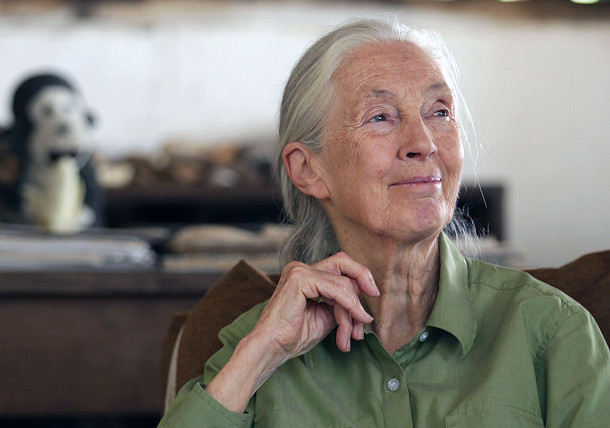
Through her speaking engagements and her Roots & Shoots program, Jane has inspired people from all over the world. (Photo: Simon Fraser University - Communications & Marketing, Flickr, CC BY 2.0)
CURWOOD: It’s Living on Earth, I’m Steve Curwood.
On July 14th, 1960, at the age of 26 Jane Goodall arrived in what is now Gombe National Park, Tanzania, to begin her breakthrough study of wild chimpanzees. Along the way she realized that if there were going to be chimps in the future she had best speak out on their behalf as well as for the forests and their human stewards. The last time I spoke with Jane, in 1993, we discussed her book Visions of Caliban, co-authored with Dale Peterson. And on the sixtieth anniversary of her arrival at her research site her study still continues. Jane Goodall joins us now from her home in England. Welcome back to Living on Earth!
GOODALL: Thank you for inviting me back.
CURWOOD: The last time we talked with you and your co-author at the time, Dale Peterson, the book "Visions of Caliban," you discuss the ways that chimps and humans are similar and different. One of the similar things was the laugh, but I didn't learn to do the greeting that time. Could I have a lesson now on the greeting, the chimp greeting?
GOODALL: It's appropriate because this is the distance greeting, and we are at a distance and most people listening are all scattered all over the place. And this is the call that a chimpanzee identifies him or herself with, they all have a slightly different one. We call it the pant-hoot. And it's [chimpanzee sounds]
CURWOOD: Okay, so, now that's for Jane Goodall. So what would a Steve Curwood say?
GOODALL: Well you just do it a bit deeper, but the main thing is it's all one breath. It's like a dog panting. You can put your own sound in it.
CURWOOD: [chimpanzee sounds]
GOODALL: Okay, slightly odd ending but apart from that very good.
CURWOOD: [chimpanzee sounds]
GOODALL: [laughs]
CURWOOD: So, we're celebrating now the 60th anniversary of your arrival to what is now what, Gombe National Park in Tanzania.
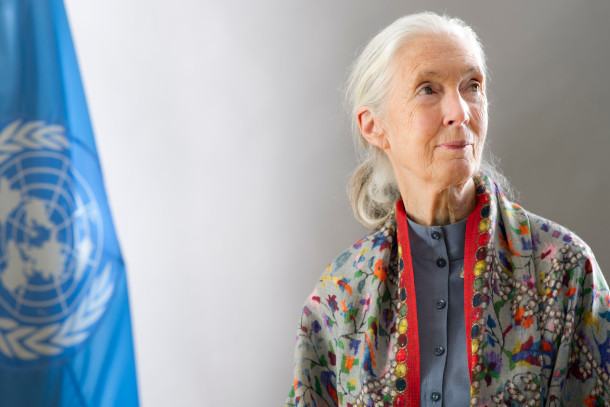
Jane Goodall has served as a United Nations Messenger of Peace since 2002, helping the UN tackle environmental issues. (Photo: United Nations Photo, Flickr, (CC BY-NC-ND 2.0)
GOODALL: Yeah.
CURWOOD: Take me back to that very first day. How did you feel when you stepped into the forest there?
GOODALL: Well, going along the lake, you know, it's on the edge of Lake Tanganyika, and I was looking up at the thickly forested hills, and it looked so big and I was thinking, you know, how am I going to find them? But, so we got there, got to the camp, put up a tent, and then it was getting towards evening when I nipped up the opposite slope a little way by myself, and I sat there looking out over the lake through these trees, and a troop of baboons came by and I heard a bushbuck barking and it was like, this is my dream come true. I'm in paradise. It was truly magic. Then, of course, as the days and weeks and months went by, the chimps were still running away from me, and I knew that with time I could get their trust, but there was only money for six months. But, you know, fortunately, the one who began to lose his fear demonstrated that chimpanzees can use and make tools, something which Western science decided only humans could do. And so that brought in National Geographic Society, they sent a photographer/filmmaker Hugo Van Lawick. And when the reports of what I was observing, and his pictures and film were circulating, the scientists just had to give up. They could no longer say, "Oh, why should we believe her? She's just a girl."
CURWOOD: Your toolmaking friend - talk to me about his name and why you picked it.
GOODALL: Well, David Greybeard had this beautiful white beard. Now, why David Greybeard, I don't know. The chimps just got names. I was told I should have numbered them by the scientists, but they all have their own personalities. They can all have feelings - happiness, sadness, fear, despair, grief. They have a territory, they patrol the territory, they can engage in a kind of primitive war. They also show compassion and true altruism as when an adult male will adopt a motherless orphan even though that child is not related.
CURWOOD: So, one of the special things about your story, of course, is that you have your mother with you at times, which is a different perspective than many scientists have.
GOODALL: My first trip to Africa was in 1957. I was on my own. Mom let me go off on this boat; there were no planes going back and forth then, and you know, that was, that trip was when I met Louis Leakey. But it was when I went back the second time when, once Leakey got money for me to study the chimps, the British Authority, Tanzania, was still part of the crumbling British Empire on its last legs, and they said no, we're not taking responsibility for a young girl on her own, she must come with somebody. And so my mother volunteered. And it was amazing because she was there; one, she set up a little clinic for the local fishermen, and that started right from the beginning a really good relationship with the local people. And secondly, when I was depressed in those first months, when the chimps ran away from me, she would be there in the evening, pointing out that actually I was learning more than I thought. I found this peak, and with my binoculars, I could see how the chimps were making nests at night. I could hear their calls, I could see what they were eating. I could see how they traveled around in different size groups, and sometimes all of them got together when it was the new fruit, ripe in season.
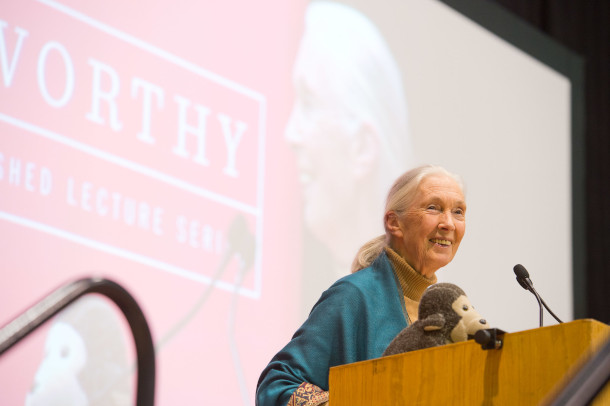
Jane normally travels the world 300 days a year, sharing her story and inspiring future generations of environmentalists. (Photo: The University of Winnipeg, Flickr, (CC BY-NC-ND 2.0)
CURWOOD: You had this wonderful tool documentation breakthrough, as a woman scientist, that of course, put the wind under your wings and allowed you to move forward. But what would you say to women scientists today who, I'm afraid to say, often run into an awful lot of opposition themselves?
GOODALL: Well, I always say, you know, whether you're male or female, if you want to do science, a particular branch of science, first of all, you've got to really want to do it because there's competition. It doesn't matter what sex you are, or what color your skin is, there's competition to get into a lot of these fields. So you've got to really work hard and do as well as you possibly can, so that at least academically you can compete on an equal footing. And there's much, much less discrimination against women now than there was back in the, in the early 60s when I began. But you see I was lucky. There was, there was nobody to compete with because nobody else was doing it. It was just me.
CURWOOD: So there was a pivotal moment in your life Jane when you traveled from Gombe to a conference as a researcher, and as you say, you left as an activist. Tell me about that moment, please.
GOODALL: I helped to put that conference together. It was four days in Chicago, and it was the first time the different chimp researchers from different fields sites in Africa came together because by then there was six other field sites. And, it was mainly to see how chimp behavior differed from environment to environment, or didn't differ as the case may be. But we had a session on conservation, and we had a session on conditions in some captive situations like medical research labs, and it was a shock. I knew there was deforestation, I had no idea the extent of it. I had no idea the speed with which chimp numbers were decreasing. And, I certainly had no idea about what went on in the medical research labs, so I just left as an activist; I didn't make a decision. I went as a scientist, I left as an activist. And, first thing I had to do was make myself go into those labs because you've got to see it firsthand. And it's been a long battle, but finally with others helping, you know, we have got chimps out of medical research. And then Africa, I learned about the plight facing so many of the African people living in and around chimpanzee habitat. And flying over Gombe, which in 1960 and 70, was part of this great equatorial forest belt that stretched right over from Western East Africa to the west coast. And when I flew over in 1990, it was just this little island of trees surrounded by completely bare hills. People struggling to survive, more than the land could support, too poor to buy food from elsewhere. And you know, this is when it hit me. If we don't help them find ways of making a living without destroying the environment, then we can't even try to save the chimpanzees. So that's where we began our take care, Tacare, program, which is our method of community-based conservation.
CURWOOD: So how does the Tacare program help both local communities and conservation?
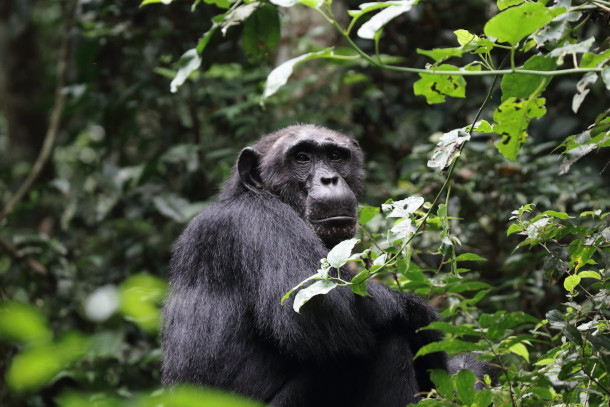
Perhaps Goodall’s most famous discovery was that chimpanzees can make and use tools, which changed the way humans think about other animals. (Photo: NH53, Flickr, CC BY 2.0)
GOODALL: Well, we've introduced microcredit based on Muhammad Yunus' Grameen Bank. So the women, particularly the women, take out tiny loans for their own environmentally sustainable projects, like getting a few chickens, selling the eggs, having tree nurseries; sometimes a slightly bigger project like shade grown coffee plantation or pineapples, something like that. And because it's not just a grant given to them, but it's a loan, when they pay it back, and they do, now it's theirs. They've done it by their own hard work. It started with 12 villages around Gombe. It's now in 104 throughout the whole of chimp range. Protecting the forest is for their own future, not only for the wildlife, because they need the forest for shade, for temperature regulations, for clean air and clean water and to prevent erosion.
CURWOOD: Now, what about your youth program that you started, I think you called it Roots and Shoots?
GOODALL: Roots and Shoots.
CURWOOD: Yeah. How did that come about? And tell me more about it.
GOODALL: It came about because when I was traveling, raising awareness about what was going on in Africa and also raising money for Tacare and chimp research, I was meeting young people who seemed to have lost hope. And they told me they felt depressed or apathetic or angry, because we've compromised their future, and there's nothing they can do about it. Well, we have compromised their future. In fact, we've been stealing it. But I didn't think it was true, there was nothing that they could do. So it all began with 12 high school students visiting me at my home in Dar es Salaam, capital of Tanzania. And we decided the main message would be: every single one of us makes some impact on the planet every single day, and we get to choose what sort of impact we make. And we decided that because in the rainforest, you learn how everything is interconnected, and every little species has a role to play, just as we all do, that every group would choose for themselves three projects: one to help people, one to help animals, one to help the environment. And because they get to choose it, they're passionate. Well, it's now in more than 86 countries, and it's got hundreds of thousands of groups. It's got members in kindergarten, university, everything in between. We've even got adult groups now. We've got a whole batch of people who've been through the program in youth, and they seem to hang on to the values. And part of this is understanding that much more important than our nationality, our language, our culture, our religion, the color of our skin, our food preferences, more important than all of that, is the fact that we're one human family. Our blood is the same if we hurt ourselves, our tears are the same, our laughter's the same. And that is something which we need so desperately today.
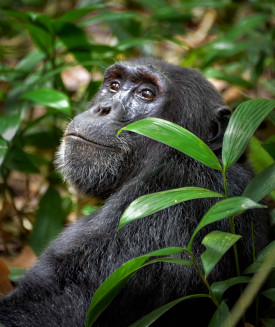
Jane Goodall discovered that chimpanzees are omnivorous, can wage war, have strong mother/infant bonds, and show acts of compassion. (Photo: Rod Waddington, Flickr, CC BY-SA 2.0)
CURWOOD: So Jane Goodall, you helped inspire so many young people through your work. How do you feel when you see now millions of young people beginning to stand up and talk about environmental issues?
GOODALL: It's wonderful, and it's not that they can change the world, they are changing the world. And you know, Roots and Shoots, yes, we do join marches and demonstrations, peaceful ones, but it's mainly about rolling up your sleeves and taking action, working out what you can do. And there's always some people passionate to help animals, to stop trafficking, for example, which is how we got the pandemic - one of the main reasons - or trying to fight factory farms or volunteering in shelters.
CURWOOD: So let's talk about what's going on right now, this pandemic and its connection to wildlife trafficking. What does this moment tell us?
GOODALL: Well, this moment tells us that we brought this entire pandemic on ourselves. The scientists studying these zoonotic diseases, those are the ones that jump from an animal to a person, have been telling us for a long time this pandemic was coming, and it won't be the last. And it's entirely because of our disrespect for animals and the natural world. So we cut down the forests, we're pushing animals in closer contact with people, animals are being trafficked, and many of them from different parts of Asia and even from Africa, are ending up in the wildlife meat markets in Asia in horrible, unhygenic conditions. And they're stacked in tiny cages, it's horrifically cruel, and the vendor and the buyer, either of them can be contaminated with blood, urine, feces. And in this sort of environment, it's the perfect opportunity for a virus or a bacteria to jump from an animal to a person. And if that binds with a cell in the human body, it might form a new disease and that disease might be contagious to other humans, as is the case with COVID-19. But, you know, it's also the conditions that we put animals in when we farm them intensively, these factory farms, and diseases have started there, jumping from an animal, a pig or a cow, to a human. So it's our fault. It's our disrespect. Here are we, the most intellectual creature that's ever walked the planet, so how come that we're destroying our only home? And we are destroying our only home very fast. We'll come out of this pandemic. We've come out of previous ones like the Black Death, but we're going to be left to face, to confront, the real existential challenge of our time, which is climate change. It was Mahatma Gandhi who said, the planet can provide for human need, but not human greed. We've become very greedy as we become more and more materialistic, and less and less having any spiritual connection with the natural world.
CURWOOD: So Jane, what are your reasons for hope?
GOODALL: Well, first of all, as I've said, it's the young people because they are changing the world. Secondly, this extraordinary brain - now we haven't used it wisely - but science is beginning to come up with really innovative technologies that will enable us to live in greater harmony with nature, and we're using our own individual brains to think about our own individual environmental footprints. I've been a vegetarian ever since the late 60s when I learned about these factory farms. And so, by not eating meat, and by increasingly turning to a plant-based diet - when I'm at home here now, I'm vegan - but it can make a huge difference. Anybody who wants to know one thing: eat less meat, or no meat. If we all make ethical choices every day, if we, if we ask about the consequences of the choices we make; where did it come from? Did it harm the environment? Was it cruel to animals? So if we make ethical choices, it'll make a big difference. And then there's the resilience of nature. I talked about the bare hills around Gombe, and there's no bare hills anymore. The trees are back. Leave the land, give it a chance, nature reclaims. Animals on the brink of extinction can be given another chance. And then there's the indomitable human spirit. The people who won't give up, they tackle what seems impossible.
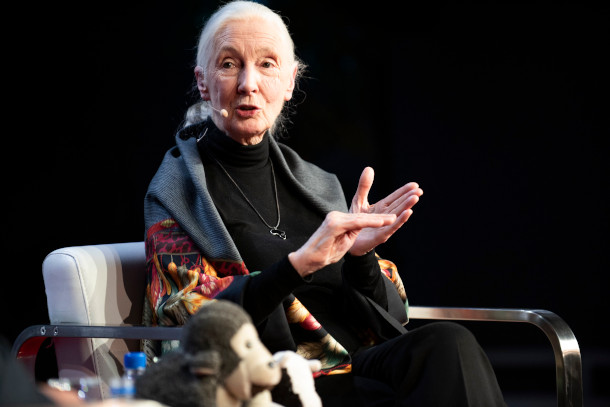
At 86 years old, Jane is still a tireless advocate for people, animals, and the environment. (Photo: Milken Institute, Flickr, CC BY-NC 2.0)
CURWOOD: Um, what's next for Jane Goodall?
GOODALL: I'm going to carry on, I'm going to grow Roots and Shoots, I'm going to visit more countries. I can just go and try and inspire the right people.
CURWOOD: So, here it is, 60 years later, what are you doing to celebrate this momentous anniversary?
GOODALL: Ha! We had so many plans that was going to be, you know, going to all the different Jane Goodall Institutes, in 24 countries now, and having galas, raising awareness, raising funds. Well, COVID-19's put that all on hold, so we're doing, you know, we're doing it virtually. I've done a reading of "In the Shadow of Man," which is the first book I did, all those early days. And we're putting a whole lot of photos which have never before been seen to illustrate it. And we'll be having, you know, events online.
CURWOOD: So, of course, you not only conducted research on chimpanzees and inspired, let's face it, the next generations of environmental activists, but, you know, you're usually on the road, what, 300 days a year to spread the message - so what keeps you motivated?
GOODALL: Because I care passionately about the environment. I care about animals. I care about children. Because I'm obstinate, you know, do you think I'm going to let the Donald Trumps and Bolsonaros and people like that knock me down and keep me down? No, I'll go on fighting till the day I die. Because I'm passionate, and because I believe we have a window of time. And you know, if everybody loses hope, if people think, well as some scientists say, you know, on the downward path, we can't do anything anymore. Well, then nobody will do anything, will they? So that's, that's what people, young people tell me and I'm going around the world, you know, well you've given me hope, I promise I'll do my bit. And it's only if we all do our bit and get together, that we can start slowing down climate change, heal some of the harm that we've inflicted.
CURWOOD: Conservationist Jane Goodall is founder of the Jane Goodall Institute and a UN Messenger of Peace. Thanks so much for taking this time with us.
GOODALL: Thank you very much.
Related links:
- The Jane Goodall Institute’s Official Website
- Roots & Shoots, an initiative of the Jane Goodall Institute
- Discovery, Innovation & Hope: Honoring the Global Impact of Gombe and Jane Goodall
- The Jane Goodall Institute | “Gombe: Nearly 60 Years of Discovery”
- CBS | “Jane Goodall on Conservation, Climate Change and COVID-19: “If We Carry on With Business as Usual, We’re Going to Destroy Ourselves”
[MUSIC: Hukwe Zawose, “Sisitizo la Amani Duniani” on Chibite, by Hukwe Zawose and Charles Zawose, Real World Records Ltd.]
CURWOOD: Living on Earth is produced by the World Media Foundation. Our crew includes Naomi Arenberg, Bobby Bascomb, Paloma Beltran, Jenni Doering, Jay Feinstein, Anne Flaherty, Don Lyman, Isaac Merson, Aynsley O’Neill, Jake Rego, Kori Suzuki, and Jolanda Omari. Today a fond farewell and special thanks to Thurston Briscoe, a fine gentleman and radio guru who is retiring. We will miss you, Thurston! Tom Tiger engineered our show. Alison Lirish Dean composed our themes. You can hear us anytime at L-O-E dot org, Apple Podcasts and Google Podcasts, and like us, please, on our Facebook page - Living on Earth. We tweet from @livingonearth. And find us on Instagram at livingonearthradio. I’m Steve Curwood. Thanks for listening!
ANNOUNCER: Funding for Living on Earth comes from you, our listeners, and from the University of Massachusetts, Boston, in association with its School for the Environment, developing the next generation of environmental leaders. And from the Grantham Foundation for the protection of the environment, supporting strategic communications and collaboration in solving the world’s most pressing environmental problems.
ANNOUNCER 2: PRX.
Living on Earth wants to hear from you!
Living on Earth
62 Calef Highway, Suite 212
Lee, NH 03861
Telephone: 617-287-4121
E-mail: comments@loe.org
Newsletter [Click here]
Donate to Living on Earth!
Living on Earth is an independent media program and relies entirely on contributions from listeners and institutions supporting public service. Please donate now to preserve an independent environmental voice.
NewsletterLiving on Earth offers a weekly delivery of the show's rundown to your mailbox. Sign up for our newsletter today!
 Sailors For The Sea: Be the change you want to sea.
Sailors For The Sea: Be the change you want to sea.
 The Grantham Foundation for the Protection of the Environment: Committed to protecting and improving the health of the global environment.
The Grantham Foundation for the Protection of the Environment: Committed to protecting and improving the health of the global environment.
 Contribute to Living on Earth and receive, as our gift to you, an archival print of one of Mark Seth Lender's extraordinary wildlife photographs. Follow the link to see Mark's current collection of photographs.
Contribute to Living on Earth and receive, as our gift to you, an archival print of one of Mark Seth Lender's extraordinary wildlife photographs. Follow the link to see Mark's current collection of photographs.
 Buy a signed copy of Mark Seth Lender's book Smeagull the Seagull & support Living on Earth
Buy a signed copy of Mark Seth Lender's book Smeagull the Seagull & support Living on Earth

